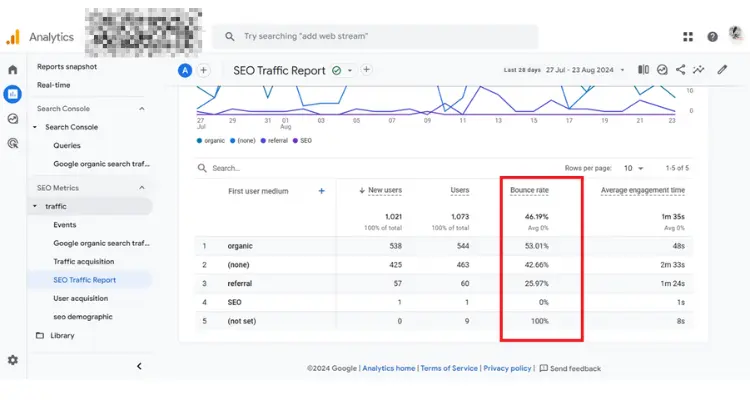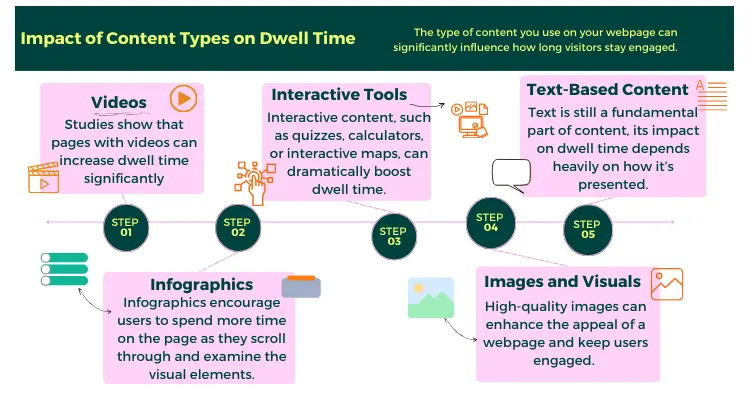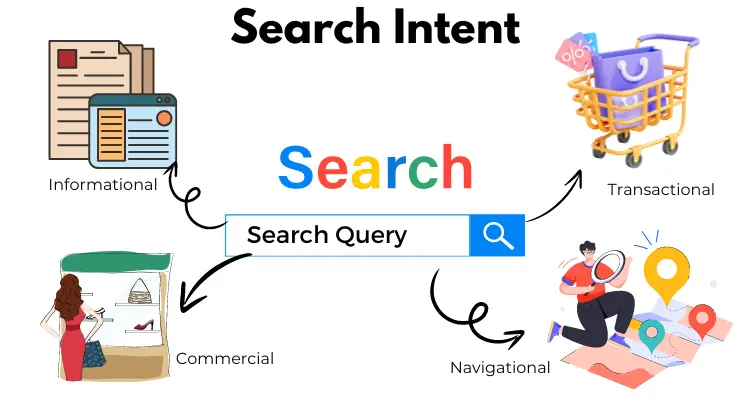- Home
- -Blog
Understanding Dwell Time: Why It Matters for Your Website

- 27 August 2024
- Shabir Ahmad
What is Dwell Time?
Dwell time is the amount of time a visitor spends on your webpage after clicking on it from a search engine results page (SERP) before returning to the search results.
In simple terms, it's a measure of how long users stay on your page before deciding whether or not your content meets their needs.
Why Should You Care About Dwell Time?
Dwell time is crucial because it gives a strong indication of how engaging and relevant your content is. If visitors are leaving your page quickly, it may signal to search engines that your content isn't satisfying their queries. This can negatively impact your website's ranking in search results.
On the other hand, longer dwell times suggest that visitors find your content useful, which can lead to better rankings and more traffic. For SEO professionals and content creators, understanding and optimizing for dwell time is essential to improving both user engagement and search visibility.
Historical Perspective on Dwell Time
The Birth of Dwell Time
The concept of dwell time first gained attention in the SEO world through its association with Bing. In the early 2010s, Bing began to recognize the importance of how long users stayed on a webpage after clicking through from search results.
This metric, known as dwell time, became an early indicator of content quality and relevance. Bing used it to help determine whether a webpage was providing value to users. If people quickly returned to the search results, it signaled that the content might not have been helpful, while longer stays suggested that the page met the user's needs.
Shifts in Perception
Over the years, the significance of dwell time has evolved, reflecting broader changes in SEO strategies and user behavior. Initially, dwell time was somewhat overlooked by many in the SEO community as it wasn't a well-publicized metric like bounce rate or page views. However, as search engines became more sophisticated, the role of user engagement metrics like dwell time grew in importance.
Today, SEO professionals recognize dwell time as a key indicator of user satisfaction and content quality. The focus has shifted from simply getting clicks to ensuring that the content retains the visitor's attention.
As search engines continue to refine their algorithms to prioritize user experience, the understanding of dwell time has expanded. It's now seen not just as a technical metric, but as a critical factor that influences overall search rankings and user engagement strategies.
Dwell Time vs. Other Metrics

Dwell Time vs. Bounce Rate
Dwell time and bounce rate are often mentioned together, but they measure different aspects of user interaction on a webpage.
Dwell time refers to the amount of time a user spends on a webpage after clicking on it from the search results before returning to the search engine. It gives insight into how engaging and relevant the content is to the user's query. A longer dwell time usually indicates that the content was valuable and met the user's needs.
Bounce rate on the other hand measures the percentage of visitors who leave a website after viewing only one page without interacting further. Unlike dwell time, bounce rate doesn't take into account how long the visitor stayed on the page.

A high bounce rate could mean that the user found the information they needed immediately or that they left because the content didn't meet their expectations.
Why Dwell Time May Be More Insightful:
- Engagement Focus:Dwell time gives a clearer picture of user engagement. For example, a user might stay on a page for a long time but still "bounce" because they found all the information they needed on that single page. In this case, a high dwell time would indicate that the content was effective, even if the bounce rate was high.
- Quality Assessment: Dwell time helps in assessing the quality of the content more directly, as it reflects whether users are actually consuming the content rather than just landing on the page and leaving.
Dwell Time vs. Session Duration and Average Time on Page
Session duration is the total time a user spends on your website during a single visit, regardless of how many pages they view. It gives an overall idea of how long users engage with your entire site, not just one specific page.
Average time on page measures the average amount of time users spend on a single page. Unlike dwell time, this metric includes all page views, whether they come from search engines, direct traffic, or other sources.
How Dwell Time Stands Apart:
- Search Engine Specificity: Dwell time specifically focuses on the time a user spends on a page after arriving from a search engine. This makes it particularly valuable for assessing how well a page meets the expectations set by its search ranking.
- Immediate Relevance: While session duration and average time on page give a broad overview of user engagement, dwell time is more focused on immediate relevance to the user's query. For example, if a user spends a long time on a page but quickly leaves the site afterwards, dwell time captures this as a positive signal, while session duration might not reflect this nuance.
Examples of Relevance:
- Dwell Time:Best used to measure how well a specific piece of content matches the user's search intent.
- Bounce Rate: Useful for identifying potential issues with landing pages where users are expected to take further actions.
- Session Duration: Effective for understanding overall engagement with the website, particularly for content that encourages multiple page views.
- Average Time on Page:Helpful in assessing the general interest level in a specific page, especially in the context of all traffic sources.
Each of these metrics provides unique insights, but when it comes to understanding how well your content satisfies a search query, dwell time offers a more focused and direct measure.
The Psychology Behind Dwell Time
Understanding User Behavior
Several psychological factors influence how long a user stays on a webpage, and understanding these can help in optimizing dwell time.
- Attention Span:
Attention spans are shorter than ever; users decide within seconds whether a webpage is worth their time. If the content doesn't immediately grab their interest, they are likely to leave quickly.To combat this, content must be engaging right from the start. This includes having a strong headline, an engaging introduction, and visually appealing elements that draw the user in immediately.
- Cognitive Biases:
Cognitive biases also play a significant role in dwell time. For example:- Confirmation Bias: Users tend to stay longer on pages that confirm their existing beliefs or expectations. If your content aligns with what they were hoping to find, they are more likely to engage with it.
- Anchoring Effect: The first piece of information a user sees can significantly influence their perception of the rest of the content. If the opening lines or visuals are strong, users are more likely to stay engaged.
- Recency Effect: Users are more likely to remember and be influenced by the last thing they see. Therefore, ending with a strong conclusion or call to action can leave a lasting impression and encourage longer engagement.
- Ease of Processing:
The easier it is for users to process the information on your page, the longer they are likely to stay. This involves clear and concise writing, logical flow, and an intuitive layout. If users have to work too hard to find the information they need, they will likely leave the page sooner.
Emotional Triggers
- Content Presentation:
The way content is presented can greatly influence dwell time. Visuals, such as images and videos, can capture attention and hold it longer than text alone. Breaking up text with subheadings, bullet points, and white space also makes the content more digestible and encourages users to stay on the page longer. - Design Elements:
The design of a webpage plays a crucial role in how users interact with the content. A well-designed page that is visually appealing and easy to navigate can significantly increase dwell time. On the other hand, cluttered or outdated designs can drive users away quickly. - Emotional Engagement:
Emotions are powerful motivators of behavior, and emotionally engaging content can keep users on a page longer. Content that evokes emotions—whether it's joy, curiosity, fear, or surprise—can captivate users and encourage them to explore more. This can be achieved through storytelling, relatable content, or compelling visuals.
By understanding and using these psychological factors and emotional triggers, you can create content that not only attracts users but also keeps them engaged for longer periods, thereby improving dwell time and overall website performance.
Impact of Content Types on Dwell Time

Different Content Formats
The type of content you use on your webpage can significantly influence how long visitors stay engaged. Here's how different formats impact dwell time:
- Videos: Videos are one of the most engaging forms of content. They combine visual and auditory elements, making it easier for users to absorb information.
Studies show that pages with videos can increase dwell time significantly because users are more likely to watch a video than read through long blocks of text.
For example, a well-placed video that explains a concept or demonstrates a product can hold a user's attention for several minutes, increasing overall dwell time.
- Infographics: Infographics are effective because they present information in a visually appealing and easily digestible format. Users can quickly understand complex data or processes, which keeps them engaged.
Infographics also encourage users to spend more time on the page as they scroll through and examine the visual elements.
- Interactive Tools: Interactive content such as quizzes, calculators, or interactive maps can dramatically boost dwell time.On Quiz Maker Wordpress, engaging quizzes encourage users to stay longer, interact with the content, and absorb information in a more enjoyable way.These tools require active participation from users, which naturally extends the amount of time they spend on your page.
For instance, a mortgage calculator or a quiz that provides personalized results can keep users engaged for much longer than static content.
- Text-Based Content:
While text is still a fundamental part of content, its impact on dwell time depends heavily on how it's presented. Long, unbroken paragraphs can deter users, leading to shorter dwell times.
However, well-structured text with clear headings, bullet points, and short paragraphs can maintain user interest, particularly if it's informative and relevant to their search query.
- Images and Visuals: High-quality images can enhance the appeal of a webpage and keep users engaged. Visuals that complement the text content, such as diagrams, photos, or graphs, can help explain concepts better and encourage users to spend more time on the page.
Best Practices
To maximize dwell time, it's essential to choose and optimize content formats thoughtfully:
- Match Content to User Intent:
 Consider what format best suits your audience's needs. For instance, a how-to guide might benefit from a combination of text and video, while data-driven content could be more effective with infographics and charts.
Consider what format best suits your audience's needs. For instance, a how-to guide might benefit from a combination of text and video, while data-driven content could be more effective with infographics and charts. - Use Multimedia Thoughtfully: Incorporate videos, images, and interactive elements where they add value. Ensure that these elements load quickly and are optimized for all devices, as slow-loading content can cause users to leave the page early.
- Optimize for Mobile: With an increasing number of users accessing content via mobile devices, it's crucial that all content formats are mobile-friendly. Responsive design and easy navigation are key to ensuring that users remain engaged on smaller screens.
- Focus on Quality and Relevance: Regardless of the format, the content must be high-quality and directly relevant to the user's query. Irrelevant or poorly produced content will lead to shorter dwell times, as users will quickly return to the search results to find better information.
- Track and Adjust: Regularly analyze which content formats perform best in terms of dwell time. Use tools like Google Analytics to monitor user behavior and adjust your content strategy accordingly. For example, if videos are increasing dwell time, consider incorporating more video content into your pages.
By selecting the right mix of content types and optimizing them for user experience, you can effectively increase dwell time, which in turn can improve your site's overall performance in search results.
Dwell Time in Different Industries
Industry-Specific Trends
Dwell time can vary significantly across different industries due to the nature of the content, user intent, and audience expectations.Here's how it typically plays out in some key sectors:
- E-commerce: In the e-commerce industry, dwell time is often shorter compared to other sectors. Users typically visit product pages with the intent to find specific information quickly, such as product details, prices, or reviews.
If the page provides the needed information effectively, users might move on to make a purchase or compare other products, resulting in a moderate dwell time. However, product pages that include comprehensive descriptions, high-quality images, videos, and customer reviews can increase dwell time by keeping users engaged longer.
- News and Media: News websites often have varied dwell times depending on the content type. Breaking news articles may have shorter dwell times as users quickly scan for the latest updates.
In contrast, feature articles, in-depth analyses, and opinion pieces tend to have longer dwell times as they require more time to read and process. Interactive elements like videos, podcasts, and comment sections can further enhance engagement and extend dwell time.
- Education and E-learning: Educational content typically sees higher dwell times, especially on platforms that offer in-depth tutorials, courses, or research articles.
Users engaging with educational content are often looking for detailed explanations and are willing to spend more time absorbing information. Interactive elements like quizzes, videos, and downloadable resources can help maintain and even increase dwell time by encouraging active participation.
- Healthcare: In the healthcare industry, dwell time can vary depending on the complexity of the information.Users seeking quick answers to health-related questions might spend less time on a page if they find their answer immediately.
However, pages offering detailed guides, symptom checkers, or video consultations often see longer dwell times, as users engage more deeply with the content.
- Finance:
Financial websites, especially those providing investment advice, market analysis, or detailed reports, generally experience longer dwell times
Users often take their time to read through financial advice, compare data, and understand market trends. High-quality graphs, calculators, and interactive tools that allow users to explore different financial scenarios can significantly enhance dwell time in this sector.
The Future of Dwell Time in SEO
Emerging Trends
The role of dwell time in SEO is likely to evolve as technology advances, user behavior changes, and search engines update their algorithms. Here are some key trends that might shape the future of dwell time:
- AI and Personalization: As artificial intelligence becomes more integrated into search engines and content platforms, we can expect dwell time to be influenced by increasingly personalized user experiences.
- Voice Search and AI Assistants: With the growing use of voice search and AI assistants like Siri, Alexa, and Google Assistant, the way users interact with content is changing.
- Interactive and Immersive Content: The rise of virtual reality (VR), augmented reality (AR), and other immersive technologies is likely to create new opportunities for increasing dwell time. Interactive content that allows users to engage deeply whether through AR experiences, VR tours, or gamified content—could lead to much longer engagement periods on websites.
- Shifts in User Behavior: As users become more accustomed to instant gratification and quick answers, the challenge will be to create content that balances quick information delivery with depth. Users may favor content that is both concise and comprehensive, requiring businesses to be more strategic in how they present information to keep users engaged
- Search Algorithm Updates: Search engines are constantly updating their algorithms to better assess user satisfaction. Future updates might place even more emphasis on user engagement metrics, including dwell time, as indicators of content quality. This could lead to more sophisticated ways of measuring how long users stay on pages and why, potentially refining the way dwell time impacts rankings.
Dwell Time for Mobile vs. Desktop Users
Mobile vs. Desktop Engagement
Dwell time often varies significantly between mobile and desktop users, primarily due to differences in screen size, content format, and browsing behavior.
- Screen Size and Readability: Mobile screens are smaller, which can affect how content is consumed.Users on mobile devices tend to scan content more quickly, leading to potentially shorter dwell times if the content isn't optimized for easy reading. Desktop users, with larger screens and often more time to engage, might spend longer on detailed content, leading to increased dwell time.
- Content Format: The format of content plays a crucial role in how long users stay on a page. Mobile users prefer content that is concise, easy to scroll through, and visually appealing, with clear headings, bullet points, and short paragraphs. Desktop users may be more inclined to engage with longer-form content that includes detailed explanations, graphs, and extensive multimedia elements.
- Browsing Behavior: Mobile users often browse on the go, which can lead to shorter sessions and lower dwell time, especially if the content is not immediately engaging or if the page is slow to load. Desktop users, on the other hand, may be in a more settled environment, such as at work or home, where they can engage more deeply with content, leading to longer dwell times.
Optimizing for Both Platforms
To maximize dwell time across both mobile and desktop platforms, it's important to tailor your content and site design to meet the unique needs of each type of user:
- Responsive Design: Ensure your website is fully responsive, meaning it automatically adjusts to fit the screen size of the device being used. This includes optimizing images, text, and layout for both mobile and desktop users to ensure a seamless experience.
- Simplify Navigation: On mobile, navigation should be straightforward, with easy access to menus and key content. Avoid cluttered designs and ensure that buttons and links are large enough to be tapped easily. For desktop users, consider a more comprehensive navigation structure that allows for deeper exploration without overwhelming the user.
- Optimize Loading Speed:Fast loading times are crucial, especially for mobile users who may be on slower networks. Compress images, use lazy loading for media, and minimize the use of heavy scripts to improve page load speed, which can positively impact dwell time.
- Content Tailoring:For mobile users, focus on concise, scannable content with strong visual elements. For desktop users, provide more detailed content, including data-heavy infographics, comprehensive guides, and videos. Ensure that both formats are engaging and meet the user's needs effectively.
- Test and Iterate:Regularly test how your content performs on both mobile and desktop platforms. Use tools like Google Analytics to track dwell time and other engagement metrics, and make adjustments based on user behavior data to continually optimize the user experience.
The Role of Storytelling in Increasing Dwell Time
Why Storytelling Matters
Storytelling is a powerful tool in content creation because it can significantly increase dwell time by capturing and holding the audience's attention.Unlike dry, factual content, stories resonate emotionally with readers, making them more likely to stay on the page and engage with the material. For example:
- Emotional Connection: Stories that tap into emotions whether it's joy, curiosity, or empathy tend to keep readers engaged longer. When users connect emotionally with the content, they are more likely to stay on the page, reflect on the content, and even share it with others.
- Relatable Scenarios: By using storytelling to present real-world scenarios or problems that the reader can relate to, content becomes more engaging.This can lead to longer dwell times as readers stay to see how the story unfolds and what solutions are offered.
- Memorable Experiences: Storytelling makes content more memorable. Users are more likely to remember and return to a site that provides them with an engaging story, which can contribute to increased dwell time over multiple visits.
Techniques to Use
Incorporating storytelling into your content can boost dwell time. Here are some practical tips:
- Create Narrative Arcs: Structure your content with a clear beginning, middle, and end. Start with a hook that draws readers in, build up the story with interesting details or challenges, and conclude with a resolution that provides value to the reader.
- Use Compelling Visuals:Enhance your story with relevant images, infographics, or videos that help to illustrate key points. Visuals not only break up the text but also help to convey emotions and ideas more powerfully, keeping users engaged longer.
- Connect Emotionally:Write in a way that speaks directly to your audience's emotions. Whether it's through the tone of voice, relatable characters, or real-life examples, making an emotional connection can significantly increase dwell time.
- Incorporate User Stories: Include testimonials, case studies, or user-generated content to add authenticity and relatability to your storytelling. When readers see themselves in the stories being told, they are more likely to stay engaged.
- Interactive Storytelling:Use interactive elements like quizzes, polls, or clickable graphics to make the story more engaging. This not only increases dwell time but also encourages deeper interaction with the content.
By effectively using storytelling techniques, you can create content that not only attracts readers but also keeps them engaged, leading to longer dwell times and improved overall user experience.
Conclusion
Dwell time is a crucial metric that provides deep insights into how well your content resonates with users. By understanding its origins and how it differs from other engagement metrics like bounce rate and session duration, you can better gauge the effectiveness of your content.
The psychology behind dwell time, including how attention spans and emotional triggers influence user behavior, highlights the importance of creating content that not only informs but also engages on a deeper level.The choice of content types whether it's videos, infographics, or interactive tools can significantly impact how long users stay on your page, making it essential to tailor your content to the preferences and behaviors of both mobile and desktop users.
Dwell time varies across industries, with each sector requiring unique strategies to optimize user engagement. Whether you're in e-commerce, news, education, or any other field, understanding your audience's specific needs and expectations is key to improving dwell time.
Looking ahead, advancements in AI, shifts in user behavior, and updates to search algorithms will continue to shape how dwell time is perceived and utilized in SEO. Staying ahead of these trends and incorporating effective storytelling techniques into your content strategy will not only boost dwell time but also enhance the overall user experience.
Ultimately, by focusing on providing value-driven, engaging content that meets the needs of your audience, you can improve dwell time, strengthen your website's performance, and achieve better search engine rankings.



